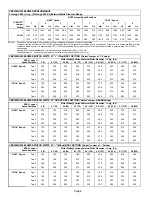
Page 15
IV−OPTIONAL ECB29/31 ELECTRIC HEAT
A−Matchups and Ratings
Tables 4, 5 and 6 show all approved CBX32MV to ECB29
matchups and electrical ratings.
B−Electric Heat Components
ECB29 parts arrangement is shown in figures 7 through 10. All
electric heat sections consist of components mounted to the
electric heat vestibule panel and electric heating elements
exposed directly to the air stream. 208/230V electric heat
sections may be equipped with circuit breakers. The circuit
breakers are designated by CB in the model number.
1−Primary(S15) & Secondary(S20) Temperature Limits
Both the primary (S15) and secondary (S20) limits are
located on the electric heat vestibule panel and are
exposed directly to the air stream through an opening in
the panel. The high temperature limits are SPST N.C.
limits with the primary limit being an auto-reset limit and the
secondary limit being a one-time" limit. One-time limits
must be replaced when opened. The limits are factory set
and are not adjustable.
208/230 Volt Electric Heat Sections
Each stage of the 208/230 electric heat is protected
by a primary (S15) and secondary (S20) high
temperature limit. Both S15 and S20 are located in the
same housing. Each stage uses the same style of limits.
Both the primary and secondary limits are wired in series
with a heat element. When either S15 or S20 opens, the
corresponding heat element is de-energized. All
other heating elements remain energized. The primary
high temperature limit opens at 150
_
F + 5
_
F (65.5
_
C +
2.8
_
C) on a temperature rise and automatically resets
at 110
_
F + 9
_
F (43.3
_
C + 5.0
_
C) on a temperature
fall. The secondary high temperature limit opens at
333
_
F + 10
_
F (167.2
_
C + 5.6
_
C) on a temperature
rise. If the secondary limit opens it must be replaced.
2−Electric Heat Sequencer Relays
(K32, K33, K34, K35, and K116) (208/230 volt only)
Relays K32, K33, K34, K35 and K116 are N.O.
sequencer relays with a resistive element for a coil
and a bi-metal disk which actuates the contacts. The
relays are located on the electric heat vestibule panel and
are energized by a 24V heating demand (W1, W2, and
W3) via jack/plug 2 (J2), which is used to connect electric
heat to the blower coil control circuit. When energized, the
internal resistance heats the bi-metal disk causing the
contacts to close. When the relay is de-energized, the
disk cools and the contacts open. The relays
energize different stages of heat, as well as the
blower. The blower is always first on and last off.
3−Circuit Breaker (CB1, CB2, and CB3)
(208/230 volt only)
Line voltage connections are made to circuit breakers
CB1, CB2, and CB3 in the electric heat sections with
circuit breakers (designated by CB in the model numbers).
Table 3 shows the amperage rating for each circuit
breaker used. Single-phase electric heat uses two pole
circuit breakers; while three-phase electric heat uses three
pole circuit breakers.
TABLE 3
ECB29 CIRCUIT BREAKERS
UNIT
CB1
AMPS
CB2
AMPS
CB3
AMPS
ECB29-5CB-1 (P)
30 AMP
−−−
−−−
ECB29-8CB-1 (P)
50 AMP
−−−
−−−
ECB29-12.5CB-1 (P)
25 AMP
50 AMP
−−−
ECB29-15CB-1 (P)
30 AMP
60 AMP
−−−
ECB29-25CB-1 (P)
50 AMP
50 AMP
50 AMP
ECB29-30CB-1 (P)
60 AMP
60 AMP
60 AMP
ECB29-15CB-1 (Y)
60 AMP
−−−
−−−
ECB29-20CB-1 (Y)
40 AMP
35 AMP
−−−
ECB29-25CB-1 (Y)
50 AMP
35 AMP
−−−
Note: Do not remove patch plate or insulation on units
without circuit breakers!!
4−Terminal Strip (TB2) 208/230 volt only)
For the electric heat sections without circuit breakers or
fuses, line voltage connections are made to terminal strip
TB2. The terminal strip is located in the lower left corner of
the electric heat vestibule panel. Single-phase electric
heat uses two pole terminal strips; while three-phase
electric heat uses three pole terminal strips.
5−Heating Elements (HE1 through HE6)
Heating elements are composed of helix wound bare
nichrome wire exposed directly to the air stream. The
elements are supported by insulators mounted to the wire
frame. For single phase applications, one element is
used per stage. Each stage is energized
independently by the corresponding relay located
on the electric heat vestibule arranged in a three
phase delta. Once energized, heat transfer is
instantaneous. High temperature protection is
provided by primary and secondary high
temperature limits.
















































